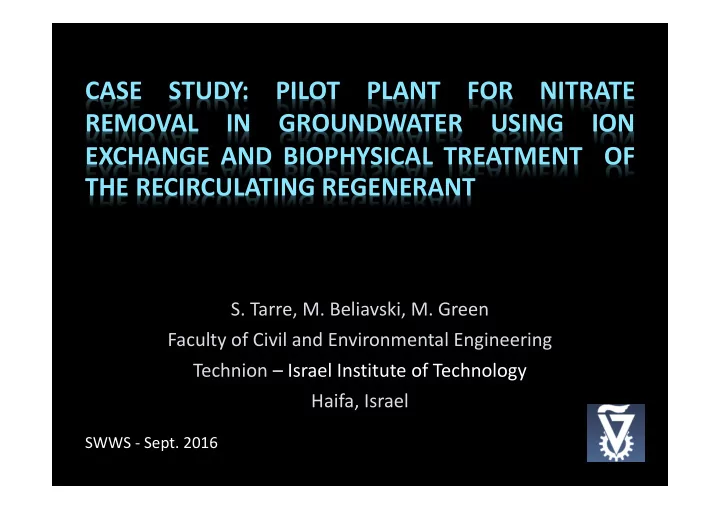

CASE STUDY: PILOT PLANT FOR NITRATE REMOVAL IN GROUNDWATER USING ION EXCHANGE AND BIOPHYSICAL TREATMENT OF THE RECIRCULATING REGENERANT S. Tarre, M. Beliavski, M. Green Faculty of Civil and Environmental Engineering Technion – Israel Institute of Technology Haifa, Israel SWWS ‐ Sept. 2016
The Problem: • In Israel, high nitrate concentrations in groundwater is the main reason for closing wells in the coastal aquifer. • In Israel, about 250 wells are closed = 80,000,000 m 3 /yr • Well size = 25 – 100 m 3 /hr
Options for Nitrate Removal from Groundwater: • The technologies for nitrate removal fall into two categories: physico ‐ chemical processes and biological processes • Physico ‐ chemical processes (ion exchange, R.O., electrodialysis) were the preferred method. Main problem is the brine produced ‐ difficult to treat and dispose • Biological process (denitrification). Disadvantages are the intensive post ‐ treatment required and stringent health regulations.
Proposed Solution : Combined ion exchange and bio ‐ regeneration process • Nitrate is separated from the water by Ion Exchange (IX). • Exhausted IX column is regenerated by brine solution recycling with a denitrifying reactor Advantages: • Almost zero brine and wastewater discharge • Separation of the biological treatment from the water supply
Combined System Scheme: Regeneration phase Adsorption phase Raw water Waste brine NO 3 rich disposal brine Biological NO 3 denitrification Selective IX (NO 3 ‐ > N 2 ) IX + resin Post ‐ treatment NO 3 free brine Product water
Combined Concept is not ‘new’: First investigated by Van der Hoek and Klapwijk, 1987; Clifford and Liu, 1993, 1996 Still not implemented on at full scale. Combined process problems: • Relatively complicated vs other processes • Poor quality of recycling regenerant brine: high DOC, high SS requiring frequent replacement , resin contamination • Still ion exchange, high chloride addition to product water and wastewater from resin washing Process Objectives: Improve recycling brine quality for extended use Minimize chloride addition to water supply Minimize brine production Minimize IX column bacterial contamination
Pilot Plant Combined System Components: Ion exchange columns – to adsorb nitrate from water Sequential Batch Reactor – to remove nitrate from brine Ozonation – for brine polishing and recycling
Minimizing Chloride Addition During Ion Exchange: ‐ to 1:1, however • Minimize Cl ‐ exchange for NO 3 ‐ and SO 4 2 ‐ ions that can be • Water also contains HCO 3 exchanged, significantly increasing product water Cl ‐ • The solution is to use a “Nitrate Selective” IX resin and extend length of ion exchange service cycle till column breakthrough
Raw and IX Product Water Composition 30 400 350 25 300 N-NO 3 and S-SO 4 mg/L 20 250 Cl mg/L 15 200 150 10 100 5 50 0 0 Raw Water 160 BV 380 BV 480 BV N-NO3 SO4-S Cl
Raw and IX Product Water Composition 30 400 350 25 300 N-NO 3 and S-SO 4 mg/L 20 250 Cl mg/L 15 200 150 10 100 5 50 0 0 Raw Water 160 BV 380 BV 480 BV N-NO3 SO4-S Cl
Brine Denitrification: Improving SBR Effluent Quality • Ethanol was used as the electron donor • HCl added to maintain pH~8.2 and Cl ‐ compensation • Ethanol dosage critical for SBR effluent quality • The solution was to supply the necessary amount of ethanol by sequential dosing and ORP monitoring and control
SBR Control 150 100 N-NO3 0 % EtOH dosage 100 -100 ORP mg/L mV 65% -200 50 -300 -400 0 0 1 2 3 4 5 6 7 8 Time (hours)
SBR Control 150 100 N-NO3 N-NO2 0 % EtOH dosage 100 -100 ORP mg/L mV 65% -200 50 -300 -400 0 0 1 2 3 4 5 6 7 8 Time (hours)
SBR Control 150 100 ORP(mV) N-NO3 N-NO2 0 % EtOH dosage 100 -100 ORP mg/L mV 10% 10% 65% 10% -200 5% 50 -300 -400 0 0 1 2 3 4 5 6 7 8 Time (hours)
Improving Poor SBR Effluent Quality (con’t) • SBR effluent has high turbidity, poor filterability and high bacterial counts. The solution was Ozonation for sustainable regenerant recycling • Near 100% suspended solids removal • High turbidity reduction from 30 NTU to 1~3 • DOC of 40 mg/l requiring IX column disinfection • Minimal waste production due to foam formation and separation
Ozone Treatment of SBR Effluent 40 35 30 Turbidity - NTU 25 20 15 10 5 0 0 30 60 90 120 150 Time - Min
Minimization of waste brine for removal: Sources of waste brine and wastewater in the system Regenerant Disinfection Disinfection IX columns flush of Waste 1 st fill; Drain 2 nd fill; Waste; H 2 O 2 Disinfectant; EC=57 EC=28 EC=1.4 EC=1.1 0.28 BV 0.66 BV 0.89 BV 0.96 BV Truck Truck Sewage Sewage 0.2% waste brine 0.4% wastewater
Tzur Moshe Pilot Summary: • Pilot Plant operated for 1 yr; regenerant not replaced • 99.4% water recovery • ‐ Nitrate was reduced from 95 to 31 mg/L as NO 3 • Chloride increased from 84 to 121 mg/L • No increase in product DOC; low bacterial counts • Competitive price $0.35/m 3
Thank you!
Recommend
More recommend